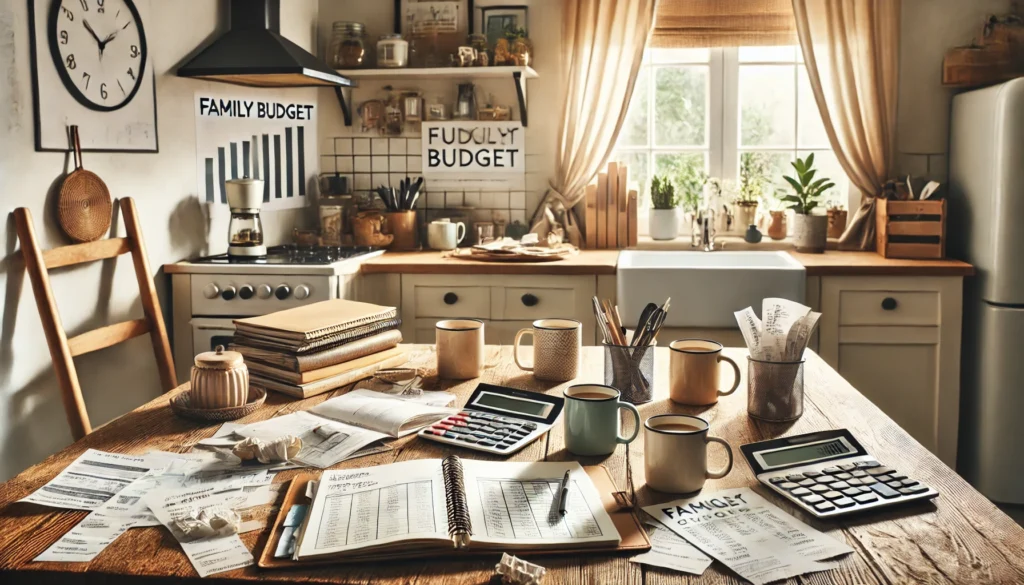A Smarter Approach to Budgeting: Why Your Household Money Plan Deserves a Reboot
When it comes to managing finances, many households find themselves caught in a recurring cycle of trying to spend less and save more—only to end up frustrated when their best efforts fail to stick. If you’ve ever found yourself wondering how to plan a household budget that actually works in the long run, you’re far from alone. A successful house budgeting strategy isn’t about creating a rigid list of expenses and income; it’s about developing a dynamic, personalized system that supports your goals, reflects your lifestyle, and evolves with your needs. True frugal living goes far beyond coupon clipping and skipping lattes—it starts with a deep understanding of how your household money flows and how to channel it more intentionally.
You may also like: 10 Genius Frugal Living Hacks: Effective Ways to Save Money on Household Bills
In today’s economic climate, where inflation and uncertainty are frequent stressors, it’s more important than ever to build a household budget that not only tracks every dollar but also empowers you to live well on less. This doesn’t mean making endless sacrifices. Instead, it’s about uncovering inefficiencies, optimizing your spending, and aligning your financial behaviors with what matters most. Through expert-level insights and practical examples, this guide explores the foundations and finer details of effective budgeting, helping you develop a resilient financial strategy.
We’ll walk through the process of identifying spending leaks, integrating automation, leveraging smart tools, and shifting your mindset from reactive to proactive money management. If you’ve ever asked yourself, “How do you create a household budget that lasts?” or felt unsure about the best place to start, this in-depth exploration offers the clarity and inspiration you need. From mastering expense categories to implementing frugal living hacks that yield real results, this article aims to make budgeting not just doable—but transformative.

Understanding the Foundation: What Makes a Budget Work
Before diving into the specifics of house budgeting, it’s important to grasp what sets a successful budget apart from a wishful one. A functional budget is not simply a breakdown of bills and income; it’s a living system that reflects your priorities, adapts to your circumstances, and holds you accountable in a way that doesn’t feel punitive. Many people create budgets that are either too strict or too vague, setting themselves up for failure. The key to sustainable success lies in finding the balance between structure and flexibility.
A household budget that works must include accurate, comprehensive data about your income sources and fixed and variable expenses. This means tracking every stream of money that enters and exits your household. Relying on estimations or rough guesses often leads to gaps in understanding where money is truly going. Additionally, your budget should be goal-oriented—whether you’re saving for a down payment, paying off a credit card, or building an emergency fund, clarity around these objectives will help shape your spending decisions.
Behavioral factors also influence how well a budget performs. Discipline, consistency, and regular review are just as critical as numbers on a spreadsheet. Without the habit of revisiting and adjusting your budget, even the most well-planned system can quickly become obsolete. Budgeting must be treated as a lifestyle shift rather than a temporary fix. It requires ongoing engagement and, perhaps most importantly, a positive relationship with money.
Finally, it’s essential to frame budgeting as a tool for freedom rather than limitation. When you know exactly how much household money is being spent and where it’s going, you gain control—and with control comes the power to make better financial choices. It’s this sense of ownership that distinguishes a functional budget from a theoretical one.
Clarifying Your Household Financial Picture
One of the first and most crucial steps in building a budget is gaining clarity around your current financial situation. Many individuals underestimate their true expenses or overestimate their income, leading to a skewed perception of affordability. The process begins by listing every source of income—wages, side hustles, freelance work, dividends, child support, and any other inflows of money. This establishes the baseline upon which the rest of your household money plan will be built.
Once income is clear, the next step is to identify fixed expenses—those recurring monthly bills that don’t change much, such as rent or mortgage payments, utilities, insurance, and loan repayments. These costs form the non-negotiable portion of your budget. The next layer involves variable expenses—items like groceries, gas, entertainment, and personal care—which fluctuate from month to month. These categories often contain hidden spending leaks that, once uncovered, can lead to significant savings.
It’s also important to look beyond monthly cycles and account for irregular expenses that occur quarterly, semi-annually, or annually. Things like car maintenance, subscription renewals, and holiday travel can throw off your budget if they’re not anticipated. A common mistake in house budgeting is failing to plan for these irregular but predictable expenses, which leads to unexpected shortfalls and reliance on credit cards.
By taking the time to build a comprehensive picture of your income and expenses, you lay the groundwork for a realistic, actionable household budget. This level of clarity can be surprisingly empowering, helping to remove anxiety and provide direction. When you truly understand your financial reality, you can make informed decisions about where to cut costs, where to invest, and how to adjust as circumstances evolve.
Setting Clear and Achievable Financial Goals
A strong household budget is goal-driven. Without clear targets, it becomes difficult to measure progress or stay motivated over time. Whether your aim is to eliminate debt, build savings, increase investments, or simply live within your means, your goals act as the compass that guides your spending behavior. Effective goals should be specific, measurable, achievable, relevant, and time-bound—also known as SMART goals.
Rather than stating a vague objective like “save more money,” consider a specific goal such as “save $5,000 for a family vacation by next summer” or “pay off $12,000 in credit card debt within the next 18 months.” These detailed benchmarks help you break down large ambitions into manageable steps and evaluate progress consistently. When each goal is tied to your household budget, every financial decision becomes an opportunity to move closer to what you value.
Moreover, involving the whole family in setting these goals can foster a stronger sense of ownership and cooperation. Children and spouses who understand the household money priorities are more likely to support and adhere to the family budget. Financial literacy becomes a shared experience, and this collective mindset can make frugal living feel less like deprivation and more like teamwork.
Incorporating both short-term and long-term goals ensures that your household budget remains relevant and motivating over time. Short-term goals—like building a $1,000 emergency fund or cutting monthly grocery expenses by $100—offer quick wins that build momentum. Long-term goals provide the vision and purpose that sustain your budgeting efforts over the years. Together, they create a powerful framework for intentional living.
Creating a Budget Template That Fits Your Life
No two households are identical, and neither should their budgets be. A cookie-cutter budget downloaded from the internet might provide a starting point, but it’s unlikely to account for your unique needs, values, and lifestyle. The best approach is to create a custom template that organizes your income and expenses in a way that feels intuitive and sustainable. This means choosing the right format—whether it’s a spreadsheet, budgeting app, or paper notebook—that you’ll actually use consistently.
Categorizing your expenses thoughtfully is critical. While traditional budget templates may separate costs into broad buckets like housing, transportation, and food, a more personalized template might go deeper, including subcategories like “weekday lunches,” “monthly streaming services,” or “kids’ extracurriculars.” The more accurately your budget reflects your real-life spending patterns, the more actionable and helpful it becomes.
You should also build flexibility into your template. Life doesn’t always go according to plan, and budgets need to accommodate fluctuations without derailing your overall progress. Setting aside a small percentage of income as a “buffer” or “miscellaneous” category can help absorb unexpected costs without throwing your household money off track. Flexibility fosters resilience, which is essential to long-term budgeting success.
Many households also benefit from a zero-based budgeting model, where every dollar is assigned a purpose, including savings and discretionary spending. This approach ensures that you’re not just tracking money but actively directing it. When each dollar has a job, you’re far less likely to overspend or let money slip through the cracks. A budget that mirrors your values and goals becomes a tool for empowerment rather than restriction.

Frequently Asked Questions (FAQ) About Household Budgeting
1. How do you create a household budget that adapts to financial changes?
A well-structured household budget should be flexible enough to accommodate financial changes, such as job transitions, unexpected expenses, or income fluctuations. Start by categorizing your expenses into fixed (e.g., rent, insurance) and variable (e.g., entertainment, dining out) costs. Reevaluate your budget monthly to identify areas that need adjustment. Consider setting up an emergency fund to cushion against financial instability. Adopting a proactive approach to financial planning allows you to adjust spending habits without completely overhauling your budget.
2. What are the most overlooked expenses in house budgeting?
Many people forget to include irregular expenses like annual insurance premiums, car maintenance, and holiday spending when they plan a household budget. These costs can create financial strain if not accounted for in advance. One strategy is to set aside a portion of your income each month in a dedicated savings account for these periodic expenses. Subscription services and small impulse purchases also add up, so regularly reviewing your bank statements can help identify and eliminate unnecessary costs. Being mindful of hidden fees in bank accounts or credit cards can also prevent unexpected charges.
3. How can technology help in managing household money more effectively?
Financial apps and digital tools can streamline house budgeting by tracking expenses, setting alerts for bill payments, and offering insights into spending patterns. Some budgeting apps use artificial intelligence to categorize expenses and provide personalized financial recommendations. Automated savings tools can help allocate a portion of your paycheck to different savings goals without manual intervention. Additionally, digital banking features such as round-up savings, where extra cents from purchases are transferred to savings, can gradually build wealth over time. Leveraging these technological solutions can make budgeting more intuitive and efficient.
4. What psychological factors influence how we plan a household budget?
Emotional spending, financial anxiety, and the fear of missing out (FOMO) play a significant role in budgeting success. Some individuals struggle with impulse purchases due to emotional triggers such as stress or social pressure. Creating financial goals with emotional significance—such as saving for a dream vacation or securing a child’s education—can make it easier to stick to a budget. Behavioral economics suggests that people are more likely to save when they automate their finances rather than relying on self-discipline. Understanding your financial habits and triggers can lead to a more mindful approach to money management.
5. What are effective strategies for cutting costs without sacrificing quality of life?
House budgeting does not mean eliminating all luxuries; instead, it’s about making smarter spending choices. Opt for high-quality, long-lasting products instead of cheap alternatives that need frequent replacements. Consider negotiating bills such as internet or insurance rates for better deals. Bulk buying and meal planning can significantly reduce grocery expenses while still allowing for nutritious meals. Free or low-cost entertainment options, such as community events or library memberships, can replace costly leisure activities. Prioritizing experiences over material purchases often leads to greater financial satisfaction without overspending.
6. How can couples successfully manage household money together?
Open communication is key when handling joint finances. Couples should have regular financial meetings to discuss income, expenses, and long-term goals. Maintaining both shared and individual accounts can provide a balance between financial unity and personal independence. Creating a clear agreement on discretionary spending helps prevent conflicts over money. Additionally, aligning financial values and discussing expectations early on can build a strong foundation for effective budgeting. Mutual financial transparency fosters trust and helps couples achieve their shared financial goals.
7. How can families teach children about money while maintaining a structured budget?
Teaching kids about money management at an early age helps develop lifelong financial skills. Introducing an allowance system with spending, saving, and giving categories can instill responsible financial habits. Involving children in grocery shopping and explaining budgeting decisions helps them understand the value of money. Gamifying financial lessons through apps or board games makes learning about budgeting fun and interactive. Setting long-term savings goals for children, such as funding their own toys or outings, reinforces patience and smart financial planning.
8. How do unexpected financial emergencies impact a household budget, and how can you prepare?
Emergencies like medical bills, car repairs, or sudden job loss can disrupt even the most well-planned household budget. Establishing an emergency fund with at least three to six months’ worth of expenses can prevent financial distress. Cutting back on non-essential expenses temporarily can help manage financial shocks. Reviewing insurance policies ensures adequate coverage for unforeseen situations. Additionally, having a side income or freelance work as a backup plan provides financial security in uncertain times.
9. What are common mistakes people make when learning how to plan a household budget?
One common mistake is setting unrealistic spending limits, which leads to frustration and abandonment of the budget. Another issue is failing to track small expenses, which can accumulate over time. Not adjusting the budget after major life changes, such as a salary increase or a new financial obligation, can lead to overspending. Many also forget to allocate money for savings and investments, prioritizing only immediate expenses. Regularly reviewing and fine-tuning the budget ensures long-term success and financial stability.
10. How can long-term financial planning improve your house budgeting strategy?
Long-term planning allows for more effective wealth accumulation and financial security. Investing in retirement accounts, real estate, or stocks ensures that money grows over time rather than sitting idle. A well-structured household budget should include provisions for future financial goals, such as homeownership, children’s education, or travel. Setting incremental savings milestones makes achieving financial objectives more manageable. Proper estate planning, including wills and trusts, ensures that assets are preserved and passed on according to your wishes. Taking a forward-thinking approach to budgeting prevents financial struggles and supports a comfortable future.

Conclusion: Turning Your Household Budget Into a Lifestyle of Freedom
The journey to financial control doesn’t begin with numbers; it begins with purpose. Learning how to plan a household budget that actually works is less about spreadsheets and more about self-awareness, discipline, and intentional living. By understanding your unique financial landscape, setting meaningful goals, customizing your budget system, and integrating frugal living practices, you can turn budgeting from a burdensome chore into a liberating strategy.
Frugal living isn’t about self-denial; it’s about making conscious choices that reflect what truly matters. A smart budget helps you cut through the noise of modern consumer culture, stay focused on your priorities, and build lasting security without feeling constantly deprived. It gives you the confidence to say yes to opportunities and no to unnecessary stress. The act of budgeting becomes a reflection of your values, your resilience, and your commitment to living a more intentional life.
In the end, the power of house budgeting lies in its ability to transform everyday decisions into building blocks of long-term prosperity. Whether you’re just starting out or refining your current approach, your household money plan can become the cornerstone of a more empowered and fulfilling financial future. By applying these principles and embracing a mindset of purposeful frugality, you’re not just creating a budget—you’re crafting a blueprint for a life of freedom, balance, and abundance.
frugal family budgeting tips, smart money management, personal finance tools, saving strategies for families, building an emergency fund, cutting utility bills, budgeting without stress, financial planning for households, cost-cutting home habits, intentional spending, zero-based budgeting method, managing variable expenses, family money meetings, affordable living tips, reducing grocery bills, planning annual expenses, tracking spending effectively, debt-free lifestyle planning, mindful money habits, realistic savings goals
Further Reading:
How to Budget Money: Your Step-by-Step Guide
How to plan a household budget
Legal Disclaimer
The information provided in this article is for general informational purposes only and is not intended to constitute financial, investment, legal, tax, or other professional advice. The content should not be relied upon for making any financial or investment decisions. Readers are encouraged to consult with licensed professionals, such as financial advisors, attorneys, or tax experts, to obtain personalized advice tailored to their individual circumstances. The author and publisher disclaim any liability for any actions taken or not taken based on the information provided in this article.





